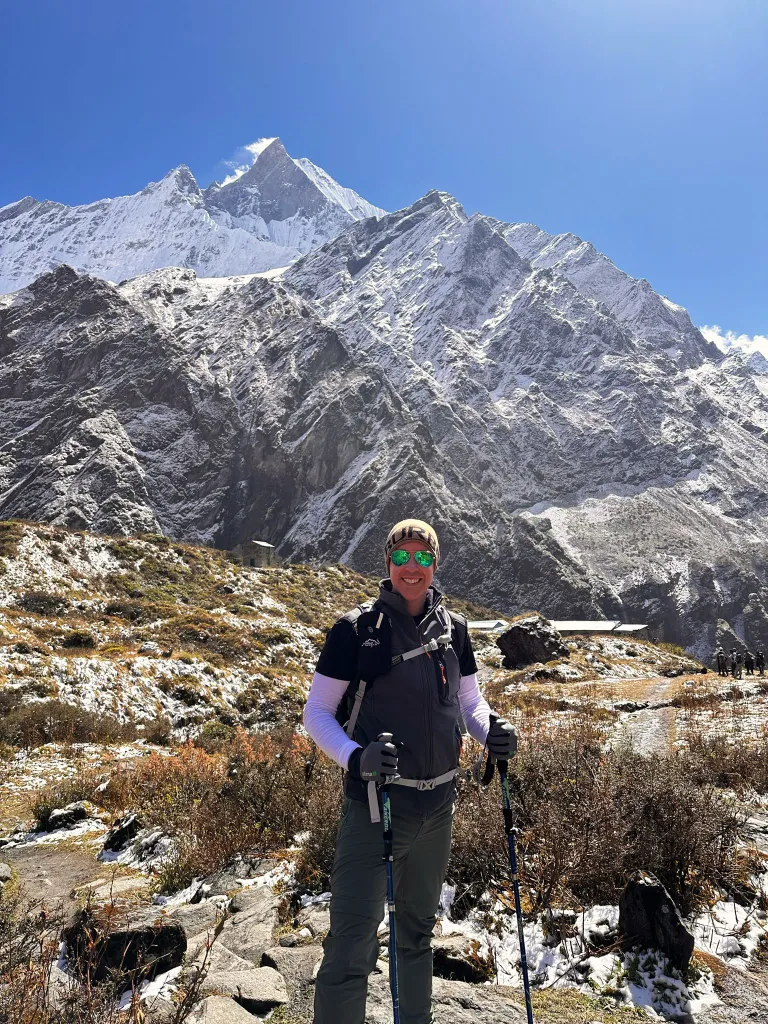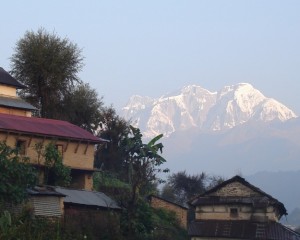Baruntse Expedition Guide: A Complete Roadmap to a Successful Ascent
The Baruntse Expedition is among the top adventures for those who are willing to climb rugged mountains and have the experience of their lifetime. Located in the Khumbu region, the Baruntse peak is ideal for an expedition that has tackled 6,000-meter peaks and is ready to take on a more demanding ascent.
The scenic flight to the gateway of Everest, Lukla, followed by the trekking trail similar to Everest Base Camp, the Baruntse Base Camp(5400m), passing through the lush forest, picturesque town, wooden suspension bridge and encountering the diverse flora and fauna of Makalu Barun National Park. Alongside the cheering views of Mount Everest (8,848.86m), Mount Lhotse (8,516m), Mount Cho Oyu (8,201m), Mount Makalu (8,463m), and Mount Kanchenjunga (8,586m). Additionally, the region is home to notable peaks such as Mera Peak (6,476m), a popular acclimatization climb before Baruntse; Lobuche Peak (6,119m), which offers stunning views of Everest and Nuptse; and Himlung Himal, a remote alternative to Baruntse when snow conditions are unpredictable.
Despite its challenges, Baruntse is considered a great stepping stone for climbers aiming for higher and more technical peaks. With proper preparation, acclimatization, and a strong mindset, it promises an unforgettable mountaineering adventure. So, we have compiled all the information required for you to start preparing for your unforgettable mountaineering adventure.
Overview Of the Baruntse Expedition
The Bartunse Expedition is a thrilling mountain adventure. You summit Bartunse Peak, one of the majestic peaks located in the Everest region near the charming Everest. You immerse yourself in the beauty of the natural and cultural gem of the Everest region without facing the crowd. As a reward, you experience the diverse flora and fauna, rugged landscape, and cultural richness.
After the short and scenic flight from Kathmandu to Lukla, you will embark on the 10-day trek through valleys, high mountain passes, and picturesque Sherpa villages. Along the way, you will spin prayer wheels, visit the monasteries scattered in the region, and pass by the encrypted mani wall "Om Pane Pemba Om," thus reaching the base camp.
You acclimatize here, and your guide will give you a brief of the summit. The summit push follows the Southeast Ridge, where you have to establish two high camps at 6,000m and 6,300m before navigating steep ice cliffs, crevasses, and exposed ridgelines leading to the top. The summit ascent is particularly demanding, featuring ice slopes up to 50 degrees and a final 7-to 10-hour climb along a narrow ridge to reach the peak. The climb to Baruntse involves a mix of ice and rock climbing, steep slopes, and glacier navigation, making it both exciting and challenging. On summit day, climbers spend 7 to 10 hours on a rugged, exposed ridgeline with the substantial requirement of determination and technical skills to navigate the steep and icy terrain.
First climbed on May 30, 1954, by Colin Todd and Geoff Harrow as part of a New Zealand expedition led by Sir Edmund Hillary. But now, many find it as a training ground for Everest. With these technical challenges, the Baruntse is an excellent training peak for future 8000m peaks to give you the essential experience in high-altitude mountaineering, rope work, and glacier travel. There are several rewards for the adventure, more than just the rewards of panoramic views.
- Conquer the rugged and diverse Baruntse Peak landscape, where a semi-technical climb tests your skills while offering an unforgettable adventure.
- Feel at home as you trek through the Everest region, immersing yourself in the rich culture of the Sherpa people, whose warmth and hospitality create a genuinely welcoming atmosphere.
- Encounter rare and awe-inspiring wildlife, including the elusive snow leopard, the red panda, and the majestic wild yak, all within the pristine wilderness of Makalu Barun National Park.
- Walk along a trail that unveils the natural beauty of the Everest region. The trail offers panoramic views of towering peaks and mesmerizing landscapes that will leave you in awe at every turn.

Is the Baruntse Expedition Difficult?
The Baruntse Expedition is an exciting yet challenging adventure that will test your ability at high altitudes. It requires technical skills and adaptability to unpredictable weather conditions.
It is moderately challenging compared to other Himalayan climbs. Plenty of factors contribute to the difficulty of climbing Baruntse Peak.
Altitude
The adventure involves trekking and physical climbing the higher mountains, so altitude is a challenge. At this altitude, the air is thinner, meaning there is less oxygen available. This causes altitude sickness, which has the initial symptoms of nausea, vomiting, shortness of breath, dizziness, and fatigue.
Further, the journey is 30 days in higher elevation, so you have to prepare for such conditions and try your best to prevent them. One prevention method is acclimatization at elevations above 2500m.
To alleviate the initial symptoms, you can hydrate yourself, pace slowly, and take Diamox, just in case. But if the condition becomes severe, it is better to get medical help.
Technical Climbing
The climb involves more than just hiking on the trail. You have to pass through the steep glacier and snow slopes, some of which are as steep as 50 degrees. Such a steep mountain requires you to have specialized skills in ice climbing and rock climbing. Along the way, there are crevasses (deep cracks in the ice or snow) and ice cliffs that can be dangerous and require careful navigation.
The use of ropes and glacier travel techniques will be your savior in navigating these challenges during the climb.
Summit Attempt:
The final push to the summit is one of the most complex parts of the expedition. You have to climb up an exposed ridgeline, which is more physically demanding and dangerous due to high winds and extreme conditions.
Similarly, there are three false summits along the way, where a summit can appear closer than it actually is. You must mentally prepare for these false summits, as reaching them and realizing they are not the top can be disheartening.
The final ascent requires determination, endurance, and mental resilience to overcome the fatigue and keep climbing until the peak is reached.
Preparation for the Baruntse Expedition
Adventure is excited to be part of the Baruntse Expedition. We have provided all the information to help you prepare for the journey, from physical and mental preparation to getting permits. We have noted the information so that you can understand the best ways to plan the ascent accordingly.
Physical Fitness and Endurance Training
Since the journey involves trekking and climbing at higher latitudes, good physical fitness is a must. You need strength and education, and you must train for at least six months to initiate the journey.
Start walking more, including weekend hikes carrying loads. Then, focus on endurance training to improve cardiovascular fitness and stamina. Strengthen your legs, core, and upper body with full-body workouts to help with climbing and carrying gear. Train in high-altitude conditions if possible so your body can adjust to lower oxygen levels.
Acclimatize gradually by including rest days and active recovery during your training. It’s essential to follow a plan that involves climbing high during the day and resting at a lower elevation at night.
Technical Climbing Skills
Aside from good physical fitness, you should also have the technical skills of rock climbing and ice climbing to navigate the terrain when you ascend the Baruntse.
Learn and practice essential skills like rope handling, ice climbing, navigating crevasses, and understanding glaciers. Focus on advanced mountaineering techniques like ice and rock climbing, using ropes, and traveling on glaciers.
Mental Preparation and Resilience
Develop mental toughness to handle the climb's challenges. Patience, focus, and self-belief will help you ascend on this month-long journey.
Practice managing stress and making decisions under pressure. Visualize the challenges you may face during the climb to prepare mentally. Build a strong team dynamic to support each other mentally throughout the expedition.
Permits
Baruntse Climbing Permit: You’ll need to obtain this from the Nepal Mountaineering Association. The fees vary by season:
- Spring (March- May): USD 500 per person
- Autumn (September-November): USD 250 per person
- Winter/Summer (December-February & June-August): USD 125 per person.
Makalu Barun National Park Permit: Required since Baruntse is within this park. The fee is about NPR 3,000 (USD 30).
Khumbu Pasang Lhamu Rural Municipality Permit: Needed to enter the Khumbu region, costing around NPR 2,000 (USD 20).
Gear and Equipment
- Clothing: Base layer (top & bottom), Mid layer (fleece or down jacket), Outer layer (waterproof jacket & pants), Insulated jacket, Gloves (warm & lightweight), Hat & neck gaiter, Socks (thermal & moisture-wicking), Gaiters, Sunglasses.
- Climbing Gear: Ice axe, Crampons, Climbing boots (technical), Helmet, Harness, Carabiners, Ropes, Slings and webbing, Ice screws, Snow stakes, Repair kit (for gear), Avalanche beacon (if needed).
- Camping Gear: Tent (4-season), Sleeping bag (cold weather), Sleeping pad, Stove and fuel, Cooking pots and utensils, Water bottles/hydration system, Food and snacks, and Waterproof stuff sacks.
- Personal Items: Passport and permits, Trekking poles, Headlamp, Camera and batteries, Personal hygiene items, First aid kit, Trekking shoes, Maps and compass.
Travel Insurance
Travel insurance is essential for mountaineering expeditions like the Baruntse climb due to the risks involved, such as medical emergencies, accidents, and altitude sickness. It covers emergency medical expenses, evacuation costs, trip cancellations or delays, lost or delayed luggage, and damaged or stolen gear. When choosing travel insurance, make sure it includes high-altitude coverage (specifically for climbs above 6,000 meters), medical evacuation, adventure sports coverage, personal liability, and 24/7 emergency assistance.
To wrap up, the Baruntse Expedition is a tough but rewarding challenge for experienced climbers. It requires physical preparation, mental strength, and technical skills. Climbing ice and rock, navigating steep slopes, and dealing with high-altitude conditions make it an actual test of endurance. Those who succeed are rewarded with stunning views and a great sense of accomplishment.
Ready for your next adventure? Explore the Himalayas with Nepal Vision Trek. Whether you're trekking or climbing, they offer expert guidance to ensure an unforgettable experience.
FAQS






